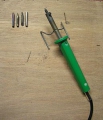Wooden Fur Stretcher Name Board: What's in a Name?
Lesson submitted by Gail Kleinschmidt (4th grade) of Northeast Range School.
The oral traditions of the Ojibwe tell of the first meeting between a wise Ojibwe man and a group of mysterious white-skinned strangers. These strangers were the first fur traders. In this lesson through reading the history chapter on the fur trade, we identify the roles of traders, clerks, voyageurs, and the American Indian suppliers and identify materials used during the fur trade. Students will use wooden fur stretchers to create a "name" board. One side of the board will have their name and the other side will be an Ojibwe word or phrase that tells something about them. They will research words or phrases using the UMN online Ojibwe People's Dictionary.As a person who has trapped fur-bearing animals for many years, I was able to bring in my own experiences as a trapper. Since I love to do hands-on projects I created this lesson and incorporated the boards used to stretch furs, the art of wood burning, and the Ojibwe language.
Objectives
- Students will learn about the Native American fur trade in Minnesota and the process of stretching and preserving furs.
- Students will choose an Ojibwe word or phrase that best describes them and write a short summary explaining why they chose this word or phrase.
- Students will learn how to use a wood burner tool.
See related lesson plan: True North Mapping: A Fur Trade LessonImage courtesy of Alertomalibu (Self-photographed) via Wikimedia Commons.
Materials Needed
Resources

Art Materials
- Graphite transfer paper
- Pencil with eraser
- Soldering iron or wood burner with stand (clay flower pot or aluminum can works for a stand)
- Tape
- White paper
- Wooden fur stretchers
Activity Process
Motivation:
We started out the unit by reading a chapter in our history book, Northern Lights: The Stories of Minnesota's Past. We then talked about the interaction of the American Indians and the European trappers. Next I brought in a variety of animal skins and explained the process of stretching and tanning of the hides. Students, who also trap, brought in their hides and shared them with their peers.
Demonstration:
Demonstrate a variety of wood burner tips to change the effects of the burning.
Activity:
- Students read fur trade chapter in history book (chapter 5)
- Discuss the process of stretching and preserving furs and review related Ojibwe words
- Have students choose and research an Ojibwe word or phrase to reflect them individually (note how their names cannot be directly translated using one word - they need to search for a meaning of "who" they are and "who they want to be known as")
- Students design their name on a piece of white paper with a pencil
- Students design their chosen Ojibwe name, word, or phrase on a separate piece of white paper with a pencil
- Students position the paper with their name using tape on one side of the wood stretcher and slip graphite paper face down between their name and the wood stretcher
- Students transfer their name onto the wood stretcher by tracing their design with a pencil so that it transfers through the graphite paper onto the wood (have them check the wood stretcher to be sure all of the lines transferred)
- Students remove both papers and using the wood burner trace the letters with a variety of shadowing and burning techniques to enhance the names (see YouTube videos for wood burning tips)
- Repeat graphite transfer and wood burning on the other side of the stretcher using their Ojibwe name, word, or phrase
- When done, invite students to hang their wood stretcher on their locker
- Students then write a short summary on what Ojibwe word or phrase they used and why they chose them
Closure:
Name boards will be displayed for all students to enjoy.
Checks:
Students are monitored throughout the project. Students must show the teacher the Ojibwe word or phrase they plan on using to ensure appropriate language.
Vocabulary Words
- Adaawaagan (Fur for trade)
- Amikwayaan (Beaver hide)
- Asekaan (Tanned hide)
- Bashkewegin (Leather, hide)
- Bonjour (French word for hello)
- Boozhoo (Hello)
- Makadewadowe (S/he has black or dark fur)
- Merci (French word for thank you)
- Miigwech (Thank you)
- Ozaawadowe (S/he has yellow or brown fur)
- Voyageur (French word for tradesman (literally traveler))
- Waagoshiwayaan (Fox hide)

Comments
The students enjoyed this activity, and especially liked using the wood burner. Researching the language and deciding on a word or phrase was challenging to some students. I used a stretcher that had been used for stretching hides and even after bleaching them they had a slight odor, so I would order a new stretcher from the North American Fur Company or another dealer. Also, make sure you have a variety of wood burner tips to change the effects of the burning.